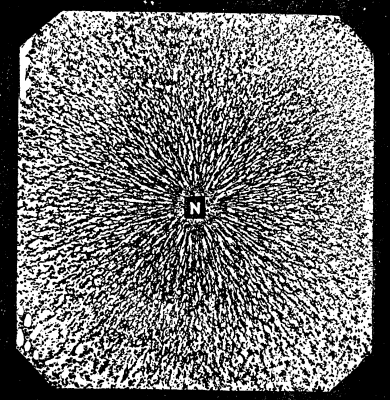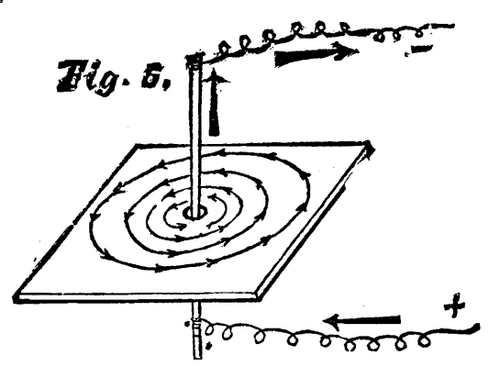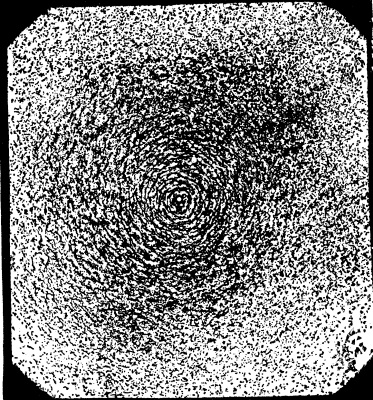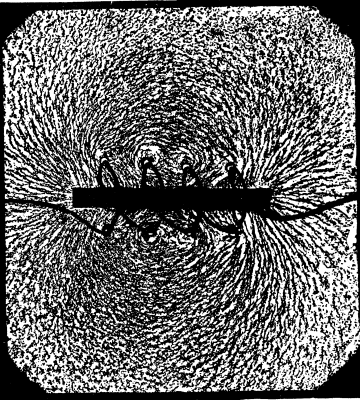On The Mechanical Production Of Electric Currents. Part 2
Description
This section is from "Scientific American Supplement Volumes 275, 286, 288, 299, 303, 312, 315, 324, 344 and 358". Also available from Amazon: Scientific American Reference Book.
On The Mechanical Production Of Electric Currents. Part 2

Fig. 3
We will next consider the space surrounding a wire through which a current of electricity is flowing. This wire has magnetic properties so long as the current continues, and will, like a magnet, act on a compass needle. But the needle never tries to point toward the wire; its tendency is always to set itself broadside to the current and at right angles to it. The "field" of a current flowing up a straight wire is, in fact, not unlike the sketch shown in Fig. 4, where instead of tufted groups we have a sort of magnetic whirl to represent the lines of force. The lines of force of the galvanic field are, indeed, circles or curves which inclose the conducting wire, and their number is proportional to the strength of the current. In the figure, where the current is supposed to be flowing up the wire (shown by the dark arrows), the little arrows show the direction in which a free north pole would be urged round the wire;[1] a south pole would, of course, be urged round the wire in the contrary direction. Now, though when we look at the telegraph wires, or at any wire carrying a current of electricity, we cannot see these whirls of magnetic force in the surrounding space, there is no doubt that they exist there, and that a great part of the energy spent in starting an electric current is spent in producing these magnetic whirls in the surrounding space. There is, however, one way of showing the existence of these lines of force; similar, indeed, to that adopted for showing the lines of force in the field surrounding a magnet. Pass the conducting wire up through a hole in a card or a plate of glass, as shown in Fig. 5, and sprinkle filings over the surface. They will, when the glass is gently tapped, arrange themselves in concentric circles, the smallest and innermost being the best defined because the magnetic force is strongest there. Fig 6 is an actual reproduction of the circular lines produced in this fashion by iron filings in the field of force surrounding an electric current.
[Footnote 1: It will not be out of place here to recall Ampere's ingenious rule for remembering the direction in which a current urges the pole of a magnetic needle. "Suppose a man swimming in the wire with the current, and that he turns so as to face the needle, then the north pole of the needle will be deflected toward his left hand."]

Fig. 4
This experimental evidence must suffice to establish two of the three fundamental points stated at the outset, for they prove conclusively that the electric current may be treated as a magnetic phenomenon, and that both in the case of the pole of a magnet, and in that of the wire which carries a current, a portion, at any rate, of the energy of the magnetic forces exists outside the magnet or the current, and must be sought in the surrounding space.

Fig. 5

Fig. 6
Having grasped these two points, the next step in our argument is to establish the relation between the current and the magnet, and to show how one may produce the other.

Fig. 7
If we wind a piece of copper wire into a helix or spiral, as in Fig. 7, and pass a current of electricity through it, the magnetic whirls in the surrounding space are modified, and the lines of force are no longer small circles wrapping round the conducting wire. For now the lines of force of adjacent strands of the coil merge into one another, and run continuously through the helix from one end to the other. Compare this figure with Fig. 1, and the similarity in the arrangement of the lines of force is obvious. The front end of the helix acts, in fact, like the north pole of a magnet, and the further end like the south pole. If a small bar of iron be now pushed into the interior of this helix, the lines of force will run through it and magnetize it, converting it into an electro-magnet. The magnetic "field" of such an electro-magnet is shown in Fig. 8, which is reproduced from the actual figure made by iron filings. To magnetize the iron bar of the electro-magnet as strongly as possible the wire should be coiled many times round, and the current should be as strong as possible. This mode of making an iron rod or bar into a powerful magnet is adopted in every dynamo-electric machine. For, as will be presently explained, very powerful magnets are required, and these magnets are most effectively made by sending the electric currents through spiral coils of wire wound (as in Fig. 8) round the bars that are to be made into magnets.

Fig. 8
The reader will at this point probably be ready to jump to the conclusion that magnets and currents are alike surrounded by a sort of magnetic atmosphere, and such a view may help those to whom the subject is fresh to realize how such actions as we have been describing can be communicated from one magnet to another, or from a current to a magnet. Nevertheless such a conclusion would be both premature and inaccurate. Even in the most perfect vacuum these actions still go on, and the lines of force can still be traced. It is probably more correct to conclude that these magnetic actions are propagated through space not by special magnetic atmospheres, but by there being movements and pressures and tensions in the ether which is believed to pervade all space as a very thin medium more attenuated than the lightest gas, and which when subjected to electro-magnetic forces assumes a peculiar state, and gives rise to the actions which have been detailed in the preceding paragraphs.
Continue to:


